The enterprise cybersecurity market is poised for massive growth by 2030 according to the latest jaw-dropping industry report. With cyber threats becoming more sophisticated every day, forward-thinking businesses need to re-evaluate their network and data security strategies for 2023 and beyond.
Gone are the days when a basic anti-virus program provided sufficient protection. Enterprise cybersecurity experts are urging companies to take a layered, defense-in-depth approach to combat the sheer volume and complexity of modern cyber-attacks. From multi-factor authentication to AI-driven threat detection, robust cybersecurity solutions are an absolute must-have.
Effective Enterprise Cybersecurity Starts with Employee Education
- Implement cybersecurity awareness training for all employees upon onboarding and annually. Training should cover phishing identification, strong password practices, safe web browsing, social engineering red flags, and reporting procedures.
- Run simulated phishing attacks to identify vulnerable employees. Use results to provide targeted education on avoiding risks.
- Ensure cybersecurity policies and standards are easily accessible to all staff. Highlight key elements like internet usage guidelines, authorized software, and WiFi protocols.
- Promote a culture of cyber vigilance through posters, newsletters, contests, and events like Cybersecurity Awareness Month.
- Make cybersecurity experts accessible to answer employee questions. Encourage reporting of suspicious activity without blame or punishment.
- Check compliance with data protection regulations. Clearly outline employee duties regarding data handling, access controls, and incident reporting.
Why AI is a Game-Changer for Enterprise Cybersecurity
| Benefit | Description |
|---|---|
| Advanced threat detection | AI analyzes large volumes of network traffic to detect anomalies indicative of malware, intrusions or data exfiltration. |
| Rapid threat identification | AI compares new threats to known patterns to quickly identify variants of ransomware, viruses and other attacks. |
| Proactive defense | AI anticipates emerging attack trends to predict and block unknown future threats. |
| Efficiency gains | AI automates tedious manual threat hunting, freeing up staff for higher value security tasks. |
| Continuous learning | AI systems continually update threat models as new cyber risks emerge. |
Expert Insights on Developing an Enterprise Cybersecurity Strategy
- Perform risk assessments to identify critical assets, vulnerabilities, and potential impact. Tailor controls to highest priorities.
- Take inventory of all connected systems and data flows. Include cloud environments and third-party integrations.
- Implement defense-in-depth with firewalls, antivirus, encryption, access controls, and intrusion detection systems.
- Establish clear cybersecurity standards, policies, and procedures. Align with regulations and best practices.
- Have an Incident Response Plan that outlines roles, communications protocols, and containment/remediation steps.
- Test defenses regularly through audits, penetration testing, and attack simulations. Identify and address gaps.
- Enable centralized monitoring and logging across environments. Analyze data to reveal weaknesses.
- Maintain a robust patching and update process to fix known vulnerabilities quickly.
- Foster collaboration between IT security and organizational leaders. Cyber risk management is a shared responsibility.
Enterprise Cybersecurity Market 2023: You Won’t Believe What Experts Are Predicting
The enterprise cybersecurity market is poised for huge growth by 2023 according to industry forecasts. Key drivers include:
- Increased cybercriminal activity – threat actors are launching larger, more sophisticated attacks against enterprise networks.
- Remote work trends – distributed workforces and cloud adoption expand the attack surface.
- Stringent regulations – governments and industries are enacting stricter data protection laws.
- Cyber insurance requirements – carriers are mandating advanced protections for policy coverage.
- Technological advances – AI, blockchain, UEBA, and other innovations provide better detection and resilience.
Experts recommend modern security strategies to match the evolving threat landscape:
- Implement robust identity and access management with MFA and privileged access controls.
- Adopt extended detection and response (XDR) for coordinated analytics across endpoints, networks, and the cloud.
- Use deception technology like honeypots to divert attackers from real assets.
- Establish security operations centers (SOCs) with 24/7 monitoring and response capabilities.
No organization can afford to be left exposed – wise CISOs will ensure their cybersecurity programs are prepared for 2023 and beyond.

How Regular Employee Cybersecurity Awareness Training Could Prevent Enterprise Network Compromise
| Frequency | Training Elements | Potential Impact |
|---|---|---|
| Monthly | Phishing simulation emails with debriefs | 68% reduction in successful phishing attacks |
| Quarterly | Cybersecurity newsletters and policy refreshers | 57% improvement in reporting of suspicious emails |
| Annually | Comprehensive cybersecurity training on the latest threats and protocols | 41% drop in malware infections from unsafe browsing |
| Ongoing | Posters and digital signage with security tips and reminders | Enhanced security culture and cyber vigilance |
Implementing AI-Driven Threat Detection: A Crucial Upgrade for Enterprise Cybersecurity in 2023
Enterprise networks face an onslaught of increasingly sophisticated threats from motivated criminals. Legacy security tools struggle to keep pace with attacks leveraging automation, machine learning and other advanced techniques. AI-driven threat detection offers next-gen protection vital for cyber resilience in 2023.
Key benefits include:
- Identifying known threats 1,000 times faster than human analysts by comparing incidents to massive threat databases.
- Spotting anomalous behavior indicative of zero-day threats through pattern recognition across billions of data points.
- Shutting down malware, bots, and unauthorized access in real-time by integrating detection with automated response.
- Continuously tuning detection algorithms and threat models based on emerging techniques observed across vast attack datasets.
- Accurately pinpointing indicators of compromise while minimizing false positives that waste security team resources.
The stakes have never been higher for safeguarding enterprise systems and data. AI-enhanced threat detection is now an essential upgrade CISOs can’t afford to ignore.
Crafting a Customized Roadmap to Enterprise Cyber Resilience: Lessons from Industry Leaders
Crafting an effective cybersecurity strategy requires aligning security controls and resources to your organization’s unique risks. Industry leaders highlight key steps for maximizing resilience:
- Conduct asset inventories, and risk and gap assessments to understand vulnerabilities, priorities, and resource needs specific to your business.
- Build a multi-year cybersecurity roadmap addressing the highest risk gaps first while laying the foundations for an eventual ideal state.
- Secure executive buy-in and funding by presenting a roadmap tied to business goals, risk tolerance, compliance obligations, and attack consequences.
- Implement a secure system development life cycle (SDLC) integrating security into applications and infrastructure from inception.
- Establish formal cybersecurity policies and standards derived from industry frameworks like NIST or ISO 27001.
- Create an incident response plan detailing roles, communications, assessment, containment, and recovery protocols.
- Test and refine defenses constantly through exercises like penetration testing, attack simulations, and crisis scenario drills.
There is no one-size-fits-all approach – crafting a strategy tailored to your unique risk landscape is key to maximizing enterprise cyber resilience.
Conclusion:
The enterprise cybersecurity market is at an inflection point going into 2023. With cyber threats growing in scale and sophistication, legacy security tools are no longer sufficient. AI-driven solutions offer a crucial upgrade to enable the threat detection and rapid response needed to match today’s attacks.
While new technologies provide advanced protections, the human element remains critical. Regular cybersecurity awareness training is fundamental to building a culture of vigilance and resilience. wise enterprises will develop layered defenses combining the best of technology and people.
Executives must make cybersecurity a top strategic priority. Savvy leaders will craft resilient roadmaps tailored to their unique risk profile. With a multi-pronged approach, enterprises can effectively manage cyber risks and safeguard their most vital assets in 2023 and beyond. The future will reward those who take proactive steps today to secure their digital transformation.

FAQs:
Q: What are the biggest cybersecurity threats for enterprises in 2023?
A: Industry experts predict more sophisticated phishing, ransomware, supply chain attacks and threats exploiting remote work will menace enterprises in 2023.
Q: How can AI technology improve enterprise cybersecurity?
A: AI enables faster threat detection, automated response and continuous learning to counter modern attacks. It is a must-have upgrade for enterprise defenses.
Q: What steps can enterprises take to improve employee cybersecurity awareness?
A: Regular training, phishing simulations, cyber tips and a visible commitment to security best practices promote vigilance.
Q: How often should enterprise cybersecurity strategies be updated?
A: Strategies should be reviewed at least annually to address new regulations, threats, technologies, and business risks.
Q: What are some key elements of an enterprise cyber incident response plan?
A: Response plans define roles, communications protocols, assessment steps, containment tactics, and recovery tasks.
Golden Quotes:
“An organization’s cybersecurity posture is only as strong as its weakest link.”

